Geographic risk assessment of Batrachochytrium salamandrivorans invasion in Costa Rica as a means of informing emergence management and mitigation
- PMID: 39724152
- PMCID: PMC11670975
- DOI: 10.1371/journal.pone.0293779
Geographic risk assessment of Batrachochytrium salamandrivorans invasion in Costa Rica as a means of informing emergence management and mitigation
Abstract
Remotely-sensed risk assessments of emerging, invasive pathogens are key to targeted surveillance and outbreak responses. The recent emergence and spread of the fungal pathogen, Batrachochytrium salamandrivorans (Bsal), in Europe has negatively impacted multiple salamander species. Scholars and practitioners are increasingly concerned about the potential consequences of this lethal pathogen in the Americas, where salamander biodiversity is higher than anywhere else in the world. Although Bsal has not yet been detected in the Americas, certain countries have already proactively implemented monitoring and detection plans in order to identify areas of greatest concern and enable efficient contingency planning in the event of pathogen detection. To predict areas in Costa Rica with a high Bsal transmission risk, we employed ecological niche modeling combined with biodiversity and tourist visitation data to ascertain the specific risk to a country with world renowned biodiversity. Our findings indicate that approximately 23% of Costa Rica's landmass provides suitable conditions for Bsal, posing a threat to 37 salamander species. The Central and Talamanca mountain ranges, in particular, have habitats predicted to be highly suitable for the pathogen. To facilitate monitoring and mitigation efforts, we identified eight specific protected areas that we believe are at the greatest risk due to a combination of high biodiversity, tourist visitation, and suitable habitat for Bsal. We advise regular monitoring utilizing remotely-sensed data and ecological niche modeling to effectively target in-situ surveillance and as places begin implementing educational efforts.
Copyright: © 2024 Adams et al. This is an open access article distributed under the terms of the Creative Commons Attribution License, which permits unrestricted use, distribution, and reproduction in any medium, provided the original author and source are credited.
Conflict of interest statement
The authors have declared that no competing interests exist.
Figures

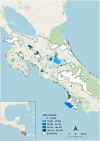
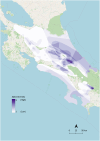
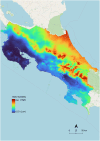
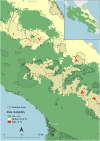
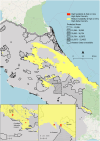
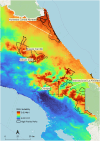
Similar articles
-
Alpine salamanders at risk? The current status of an emerging fungal pathogen.PLoS One. 2024 May 17;19(5):e0298591. doi: 10.1371/journal.pone.0298591. eCollection 2024. PLoS One. 2024. PMID: 38758948 Free PMC article.
-
Broad host susceptibility of North American amphibian species to Batrachochytrium salamandrivorans suggests high invasion potential and biodiversity risk.Nat Commun. 2023 Jun 5;14(1):3270. doi: 10.1038/s41467-023-38979-4. Nat Commun. 2023. PMID: 37277333 Free PMC article.
-
Survey of Pathogenic Chytrid Fungi (Batrachochytrium dendrobatidis and B. salamandrivorans) in Salamanders from Three Mountain Ranges in Europe and the Americas.Ecohealth. 2017 Jun;14(2):296-302. doi: 10.1007/s10393-016-1188-7. Epub 2016 Oct 5. Ecohealth. 2017. PMID: 27709310
-
Batrachochytrium salamandrivorans and the Risk of a Second Amphibian Pandemic.Ecohealth. 2017 Dec;14(4):851-864. doi: 10.1007/s10393-017-1278-1. Epub 2017 Nov 16. Ecohealth. 2017. PMID: 29147975 Review.
-
Batrachochytrium salamandrivorans' Amphibian Host Species and Invasion Range.Ecohealth. 2022 Dec;19(4):475-486. doi: 10.1007/s10393-022-01620-9. Epub 2023 Jan 7. Ecohealth. 2022. PMID: 36611108 Free PMC article.
Cited by
-
Alpine salamanders at risk? The current status of an emerging fungal pathogen.PLoS One. 2024 May 17;19(5):e0298591. doi: 10.1371/journal.pone.0298591. eCollection 2024. PLoS One. 2024. PMID: 38758948 Free PMC article.
References
-
- Daszak P, Cunningham AA, Hyatt AD. Emerging Infectious Diseases of Wildlife—Threats to Biodiversity and Human Health. Science [Internet]. 2000. Jan 21 [cited 2023 Sep 1];287(5452):443–9. https://www.science.org/doi/full/10.1126/science.287.5452.443 - DOI - PubMed
-
- Grant EHC, Muths E, Katz RA, Canessa S, Adams MJ, Ballard JR, et al.. Using decision analysis to support proactive management of emerging infectious wildlife diseases. Front Ecol Environ [Internet]. 2017. [cited 2023 Sep 1];15(4):214–21. Available from: https://onlinelibrary.wiley.com/doi/abs/10.1002/fee.1481 - DOI
-
- Martel A, Vila-Escale M, Fernández-Giberteau D, Martinez-Silvestre A, Canessa S, Van Praet S, et al.. Integral chain management of wildlife diseases. Conserv Lett [Internet]. 2020. [cited 2023 Sep 1];13(2):e12707. Available from: https://onlinelibrary.wiley.com/doi/abs/10.1111/conl.12707 - DOI
-
- Terrestrial Animal Health Code [Internet]. 27th ed. Vol. I General provisions. World Organization for Animal Health (OIE); 2018. https://www.oie.int/fileadmin/Home/eng/Health_standards/tahc/2018/en_som...
-
- Berger L, Speare R, Daszak P, Green DE, Cunningham AA, Goggin CL, et al.. Chytridiomycosis causes amphibian mortality associated with population declines in the rain forests of Australia and Central America. Proc Natl Acad Sci [Internet]. 1998. Jul 21 [cited 2023 Sep 1];95(15):9031–6. Available from: https://www.pnas.org/doi/abs/10.1073/pnas.95.15.9031 - DOI - PMC - PubMed
MeSH terms
LinkOut - more resources
Full Text Sources

